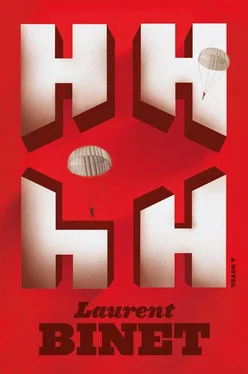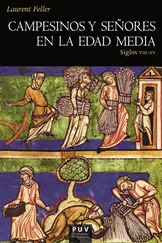Laurent Binet - HHhH
Здесь есть возможность читать онлайн «Laurent Binet - HHhH» весь текст электронной книги совершенно бесплатно (целиком полную версию без сокращений). В некоторых случаях можно слушать аудио, скачать через торрент в формате fb2 и присутствует краткое содержание. Город: New York, Год выпуска: 2012, ISBN: 2012, Издательство: Farrar, Straus and Giroux, Жанр: Историческая проза, на английском языке. Описание произведения, (предисловие) а так же отзывы посетителей доступны на портале библиотеки ЛибКат.
- Название:HHhH
- Автор:
- Издательство:Farrar, Straus and Giroux
- Жанр:
- Год:2012
- Город:New York
- ISBN:978-0-374-16991-6
- Рейтинг книги:3 / 5. Голосов: 1
-
Избранное:Добавить в избранное
- Отзывы:
-
Ваша оценка:
- 60
- 1
- 2
- 3
- 4
- 5
HHhH: краткое содержание, описание и аннотация
Предлагаем к чтению аннотацию, описание, краткое содержание или предисловие (зависит от того, что написал сам автор книги «HHhH»). Если вы не нашли необходимую информацию о книге — напишите в комментариях, мы постараемся отыскать её.
HHhH — читать онлайн бесплатно полную книгу (весь текст) целиком
Ниже представлен текст книги, разбитый по страницам. Система сохранения места последней прочитанной страницы, позволяет с удобством читать онлайн бесплатно книгу «HHhH», без необходимости каждый раз заново искать на чём Вы остановились. Поставьте закладку, и сможете в любой момент перейти на страницу, на которой закончили чтение.
Интервал:
Закладка:
As far as these matters fall within the domain of other central organizations, those organizations should be involved.
Göring stops and smiles. Eichmann added this paragraph to satisfy Rosenberg. Heydrich smiles, too, though unable to hide his contempt for these bureaucratic ministers. Göring begins to read again:
Furthermore, I charge you to submit to me as soon as possible an overall plan of the preliminary organizational, practical, and financial measures necessary for the execution of the final solution of the Jewish question such as it is envisaged.
In silence, Göring dates and signs what will become for history the Ermächtigung : the authorization. Heydrich can’t suppress a contented grin. He tidies away the precious paper in his briefcase. It’s July 31, 1941, and we are present at the birth of the Final Solution. Heydrich will be its principal architect.
109
In the first draft, I’d written: “squeezed into a blue uniform.” I don’t know why, I just imagined it being blue. It’s true that in photos Göring often sports a pale blue uniform, but I don’t know what he was wearing on that particular day. He might just as easily have been in white, for example.
I’m not sure if this kind of scruple still makes much sense at this stage.
110
Bad Kreuznach, August ’41. The second German fencing championships have just taken place. The twelve best fencers of the Reichsonderklasse [literally “elite class of the Reich”] have been chosen and will receive a gold or silver medal from the NSRL (National Socialist Society for Gymnastics). In fifth place comes an Obergruppenführer [did the magazine editors make a mistake, or are they toadying up to Heydrich by giving him an anticipated promotion?] of the SS and general of police: it’s Reinhard Heydrich, the head of the Gestapo and the SD. He joyfully received the congratulations of the public, but his whole attitude breathed the modesty of a true victor. Those who know him know that rest is, for him, an alien concept. No rest and no relaxation: that is his first principle, whether with regard to sport or to service.
(ARTICLE APPEARING IN THE SPECIALIST MAGAZINE GYMNASTICS AND PHYSICAL EDUCATION )Those who know him know that, above all, it’s better not to skimp on praise for this tremendous thirty-six-year-old athlete, nor to dwell on how stressed the judges might have been feeling when they had to decide whether to validate a strike against the head of the Gestapo. Nor is it a good idea to mention Commodus or Caligula, both of whom fought in the arena against gladiators who knew perfectly well that it was not in their interests to win against the emperor.
During the tournament, though, Obergruppenführer Heydrich seems to have behaved quite well. One day, when he cursed a judge’s decision, the tournament director put him curtly in his place by telling him, in front of everyone: “In fencing, the only laws are those of sport, and nothing else!” Stunned by the man’s courage, Heydrich didn’t even protest.
He kept his fits of hubris for other circumstances. For it was at the time of this tournament in Bad Kreuznach that he would tell two friends (since when did Heydrich have friends?), in vivid terms, that he would not hesitate to neutralize Hitler himself “if the old man gives me any shit.”
What exactly did he mean by that? I would like to know.
111
This summer, at the zoo in Kiev, a man entered the lion’s enclosure. When another visitor tried to stop him, he said, stepping over the barrier, “God will save me.” And he was eaten alive. If I’d been there, I’d have said to him: “Don’t believe everything you’re told.”
God was no help at all to the people who died at Babi Yar.
In Russian, yar means “gully.” Babi Yar, or “Grandmother’s Gully,” was a huge natural ravine just outside Kiev. Today, all that’s left is a grassed-over depression, not very deep, at the center of which is an impressive, Socialist-style sculpture commemorating those who died there. But when I went, the taxi driver showed me the place where Babi Yar had been. He took me to a kind of wooded gorge where, he explained through a young Ukrainian woman who acted as my translator, the bodies had been thrown. Then we went back to the taxi and he dropped me off at the memorial, nearly a mile away .
Between 1941 and 1943, the Nazis made of Grandmother’s Gully what is probably the largest mass grave in the history of humanity. As the commemorative plaque makes clear—in three languages (Ukrainian, Russian, and Hebrew)—more than 100,000 people perished here, victims of fascism.
More than a third of them were executed in less than forty-eight hours.
That morning in September 1941, the Jews of Kiev turned up in the thousands to the meeting point where they’d been summoned, carrying their personal effects. They were resigned to being deported. Little did they suspect the kind of exit the Germans had in mind for them.
They realized too late—some on their arrival, others not until they reached the ditch’s edge. The process was quick: the Jews gave up their suitcases, their valuable objects, and their identity papers, which were torn up in front of them. Then they had to walk between two lines of SS guards who beat them with truncheons and clubs. If a Jew fell, they let the dogs loose on him. Either that or he was trampled underfoot by the panic-stricken crowd. At the end of this infernal corridor, emerging into a hazy landscape, the stunned Jews were ordered to undress completely, then conducted naked to the lip of a gigantic ditch. There, even the most obtuse or the most optimistic must have abandoned all hope. They screamed with terror: at the bottom of the ditch was a pile of corpses.
But the story of these men, women, and children does not end above this chasm. Because, with a very German concern for efficiency, the SS—before shooting them—first made them descend to the bottom of the ditch, where a “crammer” was waiting for them. The job of this “crammer” was similar to that of an usher at a theater. He led each Jew to a pile of bodies and, having found a suitable place, made him or her lie facedown, naked and alive, on top of naked corpses. Then another guard, walking on the dead bodies, put a bullet in the back of the neck. A remarkable customization of mass killing. On October 2, 1941, the officer in charge of the Einsatzgruppe at Babi Yar wrote in his report: “Sonderkommando 4a, in collaboration with group staff and two commandos of Police Regiment South, executed 33,771 Jews in Kiev on September 29 and 30, 1941.”
112
I’ve just learned of an extraordinary story that took place in Kiev during the war. It happened in 1942 and none of the main characters of Operation Anthropoid is involved, so theoretically it has no place in my novel. But one of the great advantages of the genre is the almost unlimited freedom it gives the author.
In the summer of 1942, Ukraine is governed by the Nazis with characteristic brutality. However, they wish to organize soccer matches between the various occupied and satellite countries of the East. Now, it happens that one team soon distinguishes itself with a series of victories over Romanian and Hungarian opponents: FC Start, a team hastily assembled from the bones of the defunct Dynamo Kiev, which has been banned since the beginning of the occupation but whose ex-players are reassembled for these matches.
Rumors of the team’s success reach the Germans, who decide to organize a match in Kiev between the local side and the Luftwaffe’s team. The Ukrainian players are told they must make a Nazi salute when the teams line up.
The day of the match, the stadium is full to bursting. The two teams come out on the pitch, and the German players lift their arms and shout “Heil Hitler!” The Ukrainian players also lift their arms, no doubt a disappointment to the crowd, who see the match as an opportunity to show some symbolic resistance. But instead of shouting “Heil Hitler!,” they close their fists, bang them against their chests, and yell: “Long live physical culture!” This slogan, with its Soviet connotations, sends the crowd wild.
Читать дальшеИнтервал:
Закладка:
Похожие книги на «HHhH»
Представляем Вашему вниманию похожие книги на «HHhH» списком для выбора. Мы отобрали схожую по названию и смыслу литературу в надежде предоставить читателям больше вариантов отыскать новые, интересные, ещё непрочитанные произведения.
Обсуждение, отзывы о книге «HHhH» и просто собственные мнения читателей. Оставьте ваши комментарии, напишите, что Вы думаете о произведении, его смысле или главных героях. Укажите что конкретно понравилось, а что нет, и почему Вы так считаете.












